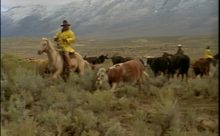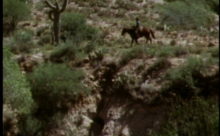Way Out West: Films on Folkstreams Highlight Cowboy Music and Culture.
A Reflection by Folklorist Joanna Zattiero
As a rural Westerner, I’ve heard people express their fears that younger generations will lose sight of their rural heritage and culture, including cowboy songs, all of my life. I’ve heard these concerns expressed by older generations as well as by those my own age, and I’ve read similar accounts from as far back as the 1860s, as the Western landscape was just beginning to be broken up by barbed wire fences, the transcontinental railroad system, and eventually interstate highways and border walls. The old cattle herding trails and oft-romanticized ideas of the open range began to shift and rural Westerners, including Native communities, surely felt the weight of what was at stake: the mercurial idea of freedom. Many feared, understandably, that this ostensible freedom would be replaced by fence lines and grid lines and signs stating “Private Property – Do Not Cross.”
Truthfully, the rural West has changed rather dramatically in many ways over the past 150 years or so. Not only was the transcontinental railroad and its web of spur lines built, but industrialization found even the most remote parts of the country through development of natural resource extraction such as mining, logging, and oil and gas drilling, land rights and public land use concerns became ever more pressing issues, and recognition of the impact of a changing climate and its associated droughts, floods, and other weather-related stressors took up a significant part of the rural West’s headspace. These concerns continue to develop and are regular topics of discussion well into the 21st century. The wide open spaces of the West are more fragmented and fragile than ever before and the conflicting demands placed upon them continue to grow just as the rural population does, but the documentary films in this collection present proof positive that the rural West and the cultures and traditions it encompasses are still vibrantly alive and well.
Cowboy songs are an indelible part of the American West and of cowboy culture and tradition, whether learned from cowboys around a campfire, from a summer camp sing-along, or from a neighbor on their front porch. These songs have been sung by cowboys and ranchers in the rural West as well as school children and movie-goers and families on road trips throughout the country for generations, and while they might be most deeply appreciated by cowboys themselves, they also speak to a deeper part of our collective American soul. Topics range from sentimental to wryly humorous and even raunchy enough to make one’s ears burn but no matter the subject, cowboy songs tend to speak to a longing for solitude that is often overwhelmed by urban and suburban life, to a yearning for connection to the landscapes and soundscapes surrounding us, and to a desire to reconnect with the rhythms of the seasons and great, wide-open spaces. They are outlets for personal expression, creativity, and emotion as well as a form of connection with generations past, present, and future.
Within this collection of documentary films, a number highlight cowboy culture and life in the rural West. These films are distillations of the Western way of life, avoiding the stereotypes and tropes that became ubiquitous more than 100 years ago through dime novels and silver screen Westerns. Instead of showing cowboys strumming guitars on horseback, wearing shiny snakeskin boots and spotless white felt cowboy hats, these films favor pragmatic realism and focus on the daily lives, concerns, and viewpoints of diverse groups of people who live and work throughout the West to this day, including itinerant Mexican and Mexican-American cowhands, female ranchers, Native Americans, and even ranch kids. In Why the Cowboy Sings, viewers are also treated to living room performances by notable artists like Glenn Ohrlin, Stephanie Davis, Henry Realbird, and Larry Schutte and his daughter Reata Schutte Brown. Insights into the daily rhythms of Western life and cowboy musical culture from people like this are simply invaluable in the current culture often centered on what is newest, fastest, and most easily accessible.
Many films in the collection touch on issues of authenticity, tradition, and Western culture and heritage. For example, conflicting demands on public lands is particularly well documented in The Cowhand’s Song, which considers the perspectives of ranching families whose cattle operations depend on access to public grazing lands as well as the concerns of a Bureau of Land Management employee who is tasked with juggling the often conflicting interests of a diversifying population of land users, each with differing stakes in the management and accessibility of the range. The cowboys featured in Highly Exalted don’t manage packed meeting schedules, wrangle spreadsheets, or drive loads of paperwork behind a desk, but they do discuss their concerns about career paths, promotions, and relationships as well as the isolation that can accompany their chosen trade. As Henry Realbird states of the song “Home on the Range,” these documentaries are also about the Western spirit of hope, and threads of both internal and external peace and conflict are interwoven throughout the films and the songs alike, highlighting the deep respect and humanity present in both.
As entertaining as modern streaming series like Yellowstone, Deadwood, and Longmire can be, they do not provide a clear and accurate window through which to interact with our roots in the American West. Rancher and singer/songwriter Larry Schutte states in Why the Cowboy Sings that he writes songs about what he’s living rather than about things that he’s made up, and while big budgets can support exceptional productions there is no real comparison between fiction, no matter how realistic, and documentaries like those available through Folkstreams. Just like one should not confuse a state fair pony ride or a dude ranch vacation with actual ranch life or a cattle drive, viewers should not take the loosely historical fiction of the commercial film industry as factual representation of the American West and its history, culture, and inhabitants.
Films like these bring together various elements of life in the West in a way that not only highlights the values of this culture but actually amplifies them, like a spotlight shone onto individual people and places and events in the darkness of night. In the film Cowboy Poets, Wallace McRae expresses his concern about the value of Western culture and history, including that of cowboy music, and who will continue to tell the stories of these people and places in the future. I would argue that the work of filmmakers and story tellers housed in collections like this is doing exactly that – telling the stories and preserving the traditions of people that might otherwise not be heard by anyone beyond their rural communities. Where else can one find discussions with and performances by singers, songwriters, poets, and ranchers like Waddie Mitchell, Stephanie Davis, Glenn Ohrlin, Henry Realbird, Lige Langston, Slim Kite, and Wally McRae among many others?
This collection provides a first-hand look at the people who continue to live and work in the rural West, from cowboys like Bill Maupin in Nevada to ranch foreman Melody Harding in Wyoming and Nondi and Crickett Long on their parents’ ranch in Oregon. While these people recognize both old and new threats to their chosen ways of life, they remain committed to preserving their history and traditions while accepting the role of an ever-modernizing world, including satellite weather reports, solar-powered cowboy camps, and the 21st century ubiquity of delivery trucks flying down endless gravel roads, kicking up sky-high plumes of dust to deliver online purchases.
As urbanization continues and family farms and ranches become harder and harder to find, let alone run in such a way as to make a reasonable living, films like these are ever more essential to a nuanced, practical understanding of the people and places that helped build both the actual and the perceived American West. As more and more people interact with the West through popular media in the form of series such as Yellowstone, we as a nation need concrete reminders that the rural West is not predominantly inhabited by ranchers in custom-made 500x beaver felt Stetson hats that cost more than most ranchers’ first pickup truck, but rather by people with many of the same concerns as the rest of the world – people who want to make sure they can put food on the table for their families, who try to balance the demands of their day-to-day jobs with the demands of their family and personal lives, and people who want to both honor and share their traditions and culture.
Collections like those within Folkstreams and Folkways are invaluable to our nation and its heritage, especially as we approach the 250th anniversary of American independence. There is so much to appreciate and learn from these resources and my hope is that they will continue to build and strengthen the collections so that future generations will have an even stronger foundation from which to learn, grow, and celebrate.



